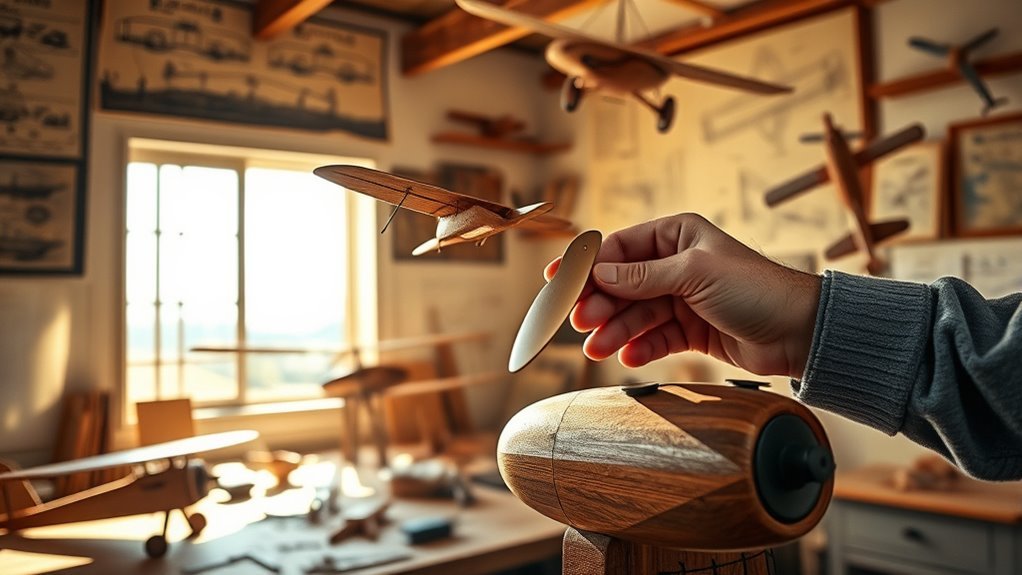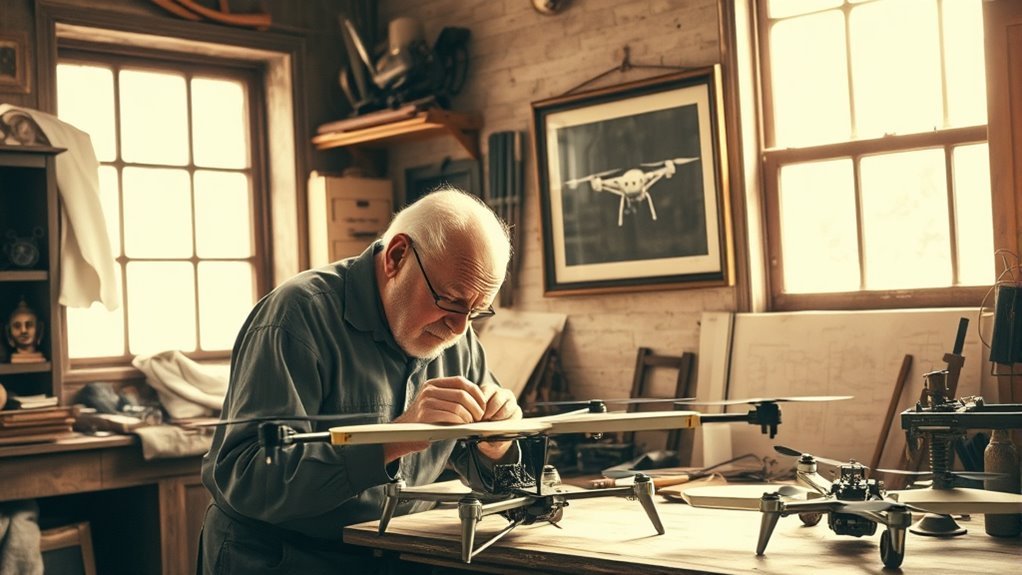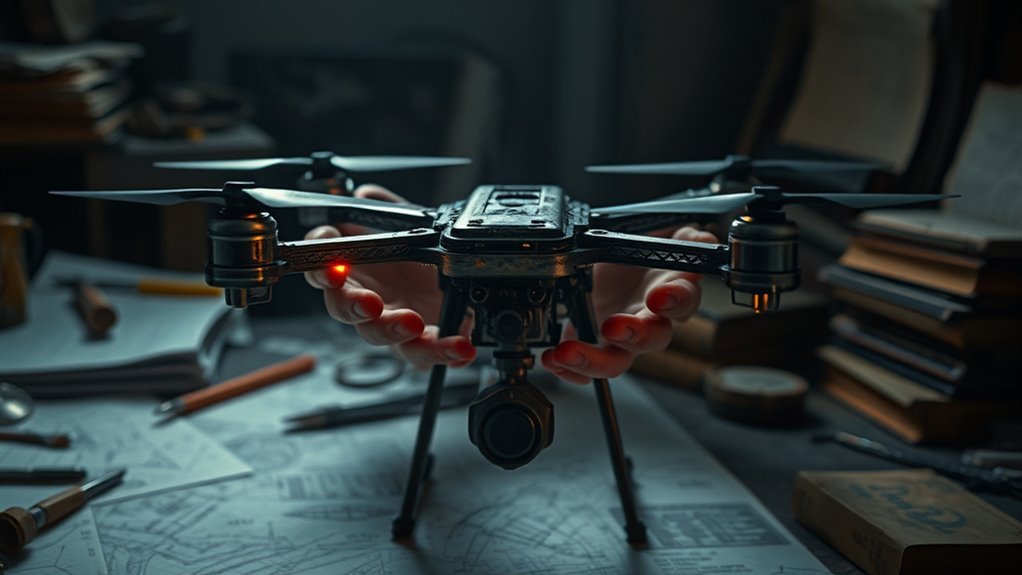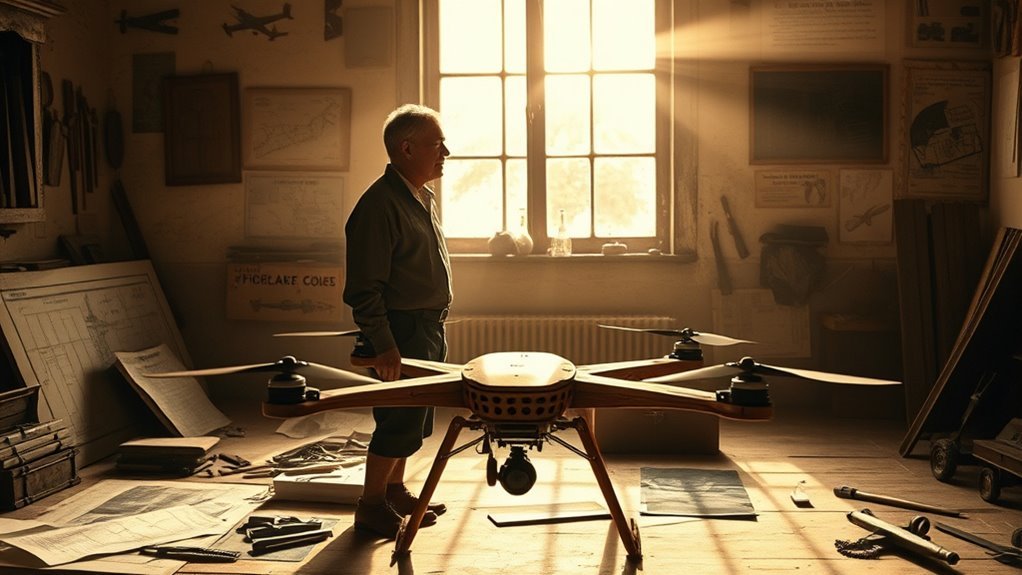The invention of drone aircraft stems from early aviation pioneers who laid the groundwork for unmanned aerial technology. Innovators like Otto Lilienthal and the Wright brothers explored powered flight, while George Cayley emphasized essential principles like lift and drag. Their foundational work eventually led to the development of unmanned aerial vehicles, greatly impacting both military and civilian applications. The evolution of this technology has opened new horizons, offering further insights into its transformative legacy in various sectors.
The Early Beginnings of Aviation

Although the concept of flight has captivated human imagination for centuries, the actual beginnings of aviation can be traced back to the late 19th and early 20th centuries, when pioneering inventors began to experiment with powered flight. Early aviation was characterized by a fervent quest for freedom in the skies, as flight pioneers such as Otto Lilienthal and the Wright brothers pushed the boundaries of technology and human potential. Their meticulous observations and experiments laid the groundwork for future advancements, demonstrating a blend of creativity and scientific inquiry. By analyzing aerodynamics and propulsion, these innovators not only transformed transportation but also sparked a movement that would redefine human experience. Their relentless pursuit of flight embodies the spirit of exploration inherent in humanity.
The Visionary Behind the Invention

When you consider the visionary behind the invention of drone aircraft, it’s essential to recognize how early innovations in aviation laid the groundwork for this technology. These foundational advancements not only revolutionized flight but also transformed modern warfare strategies, showcasing the profound impact of such creativity. Understanding this evolution offers insight into the significance of the drone’s development in contemporary military applications. The integration of advanced obstacle avoidance technology in drones like the Draganfly Commander highlights the ongoing evolution of safety features in aerial vehicles, similar to how proactive vulnerability identification enhances security automation in various domains.
Early Innovations in Aviation
As the quest for flight took shape in the early 20th century, innovators like George Cayley laid the groundwork for future advancements, including the drone aircraft. Cayley’s pioneering concepts of lift and drag were pivotal aviation milestones, shaping the trajectory of subsequent flight experiments. His detailed analyses of glider dynamics empowered future inventors to explore controlled flight, pushing the boundaries of technology. This relentless pursuit of airborne innovation fostered an environment where creativity flourished, enabling the emergence of various aircraft designs. Each advancement built upon the last, leading to the eventual development of unmanned aerial vehicles. Understanding these early innovations not only highlights the importance of visionary thinkers but also underscores the collective human desire for freedom and exploration in the skies.
Impact on Modern Warfare
The advent of drone aircraft has fundamentally transformed modern warfare, reshaping strategic paradigms and operational tactics. You’ll notice that drone strategies prioritize efficiency and precision, reducing the risk to human life while enhancing mission effectiveness. Aerial surveillance capabilities have expanded considerably, allowing for real-time intelligence gathering and advanced reconnaissance without putting personnel in harm’s way. This shift not only increases situational awareness but also influences decision-making processes at all levels of command. Furthermore, the integration of drones into combat operations has sparked ethical debates regarding the implications of remote warfare. As you consider these advancements, it’s clear that the visionary behind the invention has left an indelible mark on how nations engage in conflict and protect freedom.
The First Unmanned Aerial Vehicles

When you examine the origins of unmanned aerial vehicles, you’ll find that early concepts laid the groundwork for what we recognize today as drones. Key innovators played pivotal roles in developing these technologies, particularly in military applications that greatly advanced aerial reconnaissance. Understanding these foundational elements is essential for appreciating the evolution of drone aircraft and their impact on various fields.
Early Drone Concepts
Although many people associate drones with modern technology, the concept of unmanned aerial vehicles (UAVs) dates back to the early 20th century. Pioneers experimented with early remote control systems, primarily for military applications. These devices were initially designed for aerial surveillance, enabling reconnaissance without risking pilots’ lives. Notable examples include the Kettering Bug, developed during World War I, which was one of the first true UAVs, aimed at delivering explosives to enemy targets. These innovations laid the groundwork for future developments in drone technology. By examining these early concepts, we can appreciate how the desire for freedom in aerial exploration and intelligence gathering has driven technological advancements, shaping the UAVs we recognize today.
Key Innovators and Contributions
While early drone concepts laid the foundation for unmanned aerial vehicles, it was the contributions of key innovators that truly advanced the technology. Pioneers like Nikola Tesla and Reginald Denny helped shape the initial designs, focusing on remote control and stability. Their work set the stage for modern applications, ranging from aerial photography to surveillance.
| Innovator | Contribution | Impact |
|---|---|---|
| Nikola Tesla | Remote control technology | Enabled drone operation |
| Reginald Denny | First commercial UAV (Radioplane) | Laid groundwork for drones |
| Charles Kettering | Development of the Kettering Bug | Early military UAVs |
| John H. McGowan | Aerial photography innovations | Expanded drone usage |
As drone regulations evolved, these contributions remain pivotal in defining the scope and potential of UAV technology today.
Military Applications and Advancements
As military needs evolved, the development of the first unmanned aerial vehicles (UAVs) marked a significant turning point in warfare technology. These early UAVs provided unprecedented surveillance capabilities, enabling military forces to gather intelligence without risking human lives. By leveraging advanced technology, they offered tactical advantages that transformed reconnaissance missions. UAVs could operate in hostile environments, delivering real-time data and evaluating threats with remarkable precision. This shift not only enhanced operational efficiency but also altered strategic planning, allowing military leaders to make informed decisions. As you explore the implications of UAVs, consider how their integration into military operations has redefined concepts of engagement, autonomy, and the ethical dimensions of warfare, ultimately shaping the future of defense strategies.
Technological Advancements in Drone Development
Since the inception of drone technology, significant advancements have transformed these unmanned aerial vehicles from rudimentary prototypes into sophisticated systems capable of a wide range of applications. You’ll notice that innovations like autonomous navigation have allowed drones to operate independently, enhancing their utility in fields such as agriculture, surveying, and emergency response. Additionally, advancements in aerial photography have revolutionized how we capture and analyze visual data, providing unprecedented insights for industries ranging from real estate to environmental monitoring. These technological enhancements not only improve efficiency but also expand the potential for creativity and exploration. By embracing these developments, you’re not just witnessing a technological evolution; you’re participating in a movement that champions freedom, autonomy, and innovation in various domains. The integration of AI and real-time data processing further enhances operational capabilities, ensuring drones can adapt to dynamic environments and deliver insightful analytics. Furthermore, the advanced surveillance and reconnaissance capabilities of drones provide real-time threat detection, significantly improving their effectiveness in tactical operations.
The Role of Drones in World War I
Although often overshadowed by traditional manned aircraft, drones played a pivotal role in World War I, marking the beginning of their military application. These early unmanned vehicles were primarily utilized for aerial reconnaissance, providing critical intelligence to military strategists. By capturing images and relaying information from the skies, drones enhanced situational awareness, allowing commanders to make informed decisions on troop movements and resource allocation. This shift in military strategy not only showcased the potential of unmanned technology but also set a precedent for future conflicts. The effectiveness of drones in gathering intelligence demonstrated their value in warfare, prompting further interest in their development and use. Consequently, World War I laid the groundwork for the evolution of drone technology in military operations.
Expanding Applications of Drones in Civilian Life
While the military applications of drones have garnered significant attention, their potential in civilian life is rapidly expanding across various sectors. You may not realize how integral drones are becoming in areas like commercial delivery and agricultural monitoring. These innovations are revolutionizing efficiency and effectiveness. Drones are particularly transforming agriculture through precision planting techniques, optimizing seed placement and resource utilization.
| Application | Impact | Examples |
|---|---|---|
| Commercial Delivery | Fast, reliable shipping | Amazon Prime Air |
| Agricultural Monitoring | Enhanced crop management | Precision farming |
| Environmental Surveying | Data collection on ecosystems | Wildlife tracking |
| Disaster Response | Quick aid assessment | Emergency relief efforts |
| Infrastructure Inspection | Cost-effective evaluations | Bridge and building checks |
From search assistance to aerial photography and wildlife conservation, drones are reshaping how we interact with the world, providing profound opportunities for a freer, more efficient society. Moreover, real-time detection of inefficiencies in agricultural monitoring through multispectral cameras optimizes resource use and enhances crop yields.
The Evolution of Drone Technology
As drone technology has advanced, its transformation from military tool to ubiquitous civilian device reflects a remarkable journey of innovation and adaptation. You’ll notice that the evolution hinges on the development of lightweight, durable drone materials, which have greatly enhanced performance and accessibility. The integration of advanced sensors and batteries has also propelled utility across various sectors, from agriculture to delivery services. Moreover, AI-enhanced obstacle avoidance features have significantly improved flight safety, enabling drones to navigate complex environments with precision. However, regulatory challenges persist, often limiting operational capabilities and stifling innovation. Maneuvering through these regulations can be intimidating, yet they’re essential for ensuring safety and privacy. As you explore this landscape, consider how the balance between technological advancement and regulatory frameworks will shape the future of drone usage and its potential to enhance personal freedom and creativity in various fields. AI-driven autonomous navigation will play a crucial role in ensuring safer flights and expanding the potential applications of drones.
Modern Innovations and Future Prospects
With the rapid pace of technological advancement, modern innovations in drone technology are redefining possibilities across various industries. You’re witnessing the rise of autonomous systems that enhance efficiency and safety in operations. These systems can perform complex tasks without human intervention, allowing for groundbreaking applications in logistics, agriculture, and disaster response. Aerial surveillance is another significant area where drones excel, providing real-time data for security, environmental monitoring, and urban planning. As you explore these advancements, consider the implications for privacy and regulation, which are equally crucial in shaping the future of drone technology. Additionally, understanding the factors that influence radar detection is essential for ensuring safe and compliant drone operations. The possibilities are vast, and as innovations continue to unfold, you’ll find that the freedom to utilize drones responsibly is essential for maximizing their benefits. The growth in delivery applications demonstrates the increasing versatility and functionality of drones in everyday operations.
Honoring the Legacy of the Drone Pioneer
The legacy of the drone pioneer is marked by transformative contributions that have laid the groundwork for today’s advanced aerial technologies. Their pioneering spirit and technological foresight not only revolutionized military applications but also opened doors for civilian uses that enhance freedom and innovation. By recognizing their achievements, you honor a vision that transcended conventional boundaries, inspiring future generations to explore uncharted territories in aviation. The integration of drones into various sectors—like agriculture, surveillance, and logistics—reflects the profound impact of their work. As you reflect on this legacy, consider how the principles of exploration and innovation continue to shape our world, empowering you to leverage these technologies for societal benefit and personal creativity. Additionally, the use of drones in public health applications demonstrates their capacity to deliver essential medical supplies swiftly, transforming healthcare delivery in remote areas. Embrace this legacy; it’s yours to carry forward. The advancements in autonomous spraying technology demonstrate the ongoing evolution of drone applications that enhance agricultural efficiency and sustainability.
Frequently Asked Questions
What Inspired the Pioneer to Pursue Drone Technology?
You might find that the pioneer’s innovation motivation stemmed from a blend of technological curiosity and the desire to explore new frontiers, seeking to create solutions that could redefine aerial capabilities and enhance human experience.
How Did Early Public Perception of Drones Differ From Today?
You’d find it fascinating how early public perception of drones, marked by military applications and public skepticism, contrasts sharply with today’s views, where they’re embraced for innovation, convenience, and expanding personal freedoms.
Were There Any Notable Competitors to the Drone Inventor?
You’ll find that notable competitors in drone innovation focused on military applications and commercial uses, each contributing unique advancements. These rival inventors shaped the landscape, pushing boundaries and expanding possibilities in aerial technology markedly.
What Challenges Did the Pioneer Face During Development?
Imagine tackling innovation amidst technical limitations and funding hurdles. You’d face skepticism from investors and engineers, struggling to transform visionary ideas into reality, all while maneuvering the relentless pressure of an evolving technological landscape.
How Has Drone Technology Impacted Environmental Monitoring?
Drone technology’s revolutionized environmental monitoring, enabling you to gather precise environmental data efficiently. It’s essential for wildlife conservation efforts, allowing you to track species, assess habitats, and respond swiftly to ecological changes impacting biodiversity and ecosystems.

